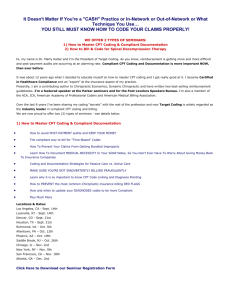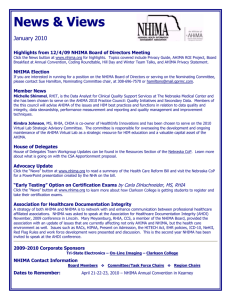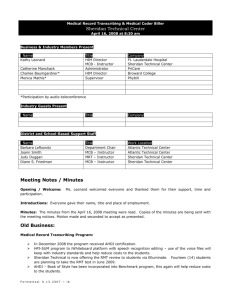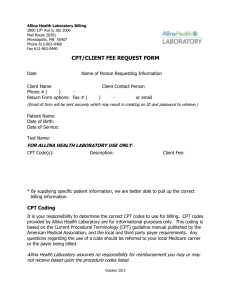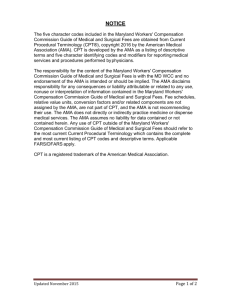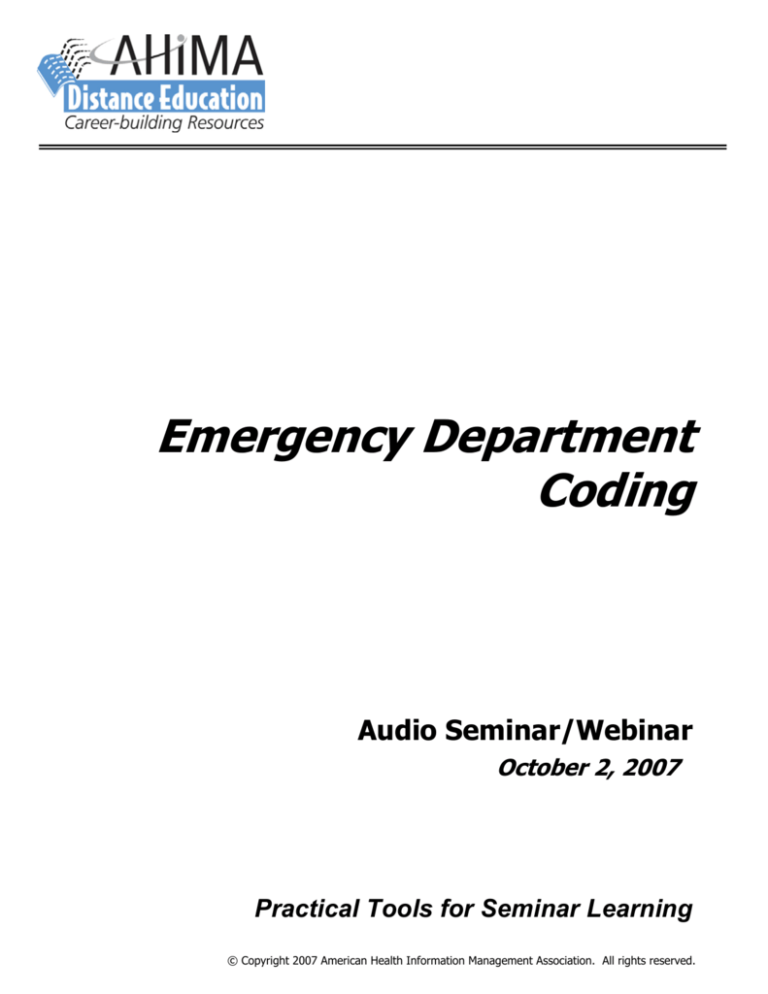
Emergency Department
Coding
Audio Seminar/Webinar
October 2, 2007
Practical Tools for Seminar Learning
© Copyright 2007 American Health Information Management Association. All rights reserved.
Disclaimer
The American Health Information Management Association makes no
representation or guarantee with respect to the contents herein and specifically
disclaims any implied guarantee of suitability for any specific purpose. AHIMA has
no liability or responsibility to any person or entity with respect to any loss or
damage caused by the use of this audio seminar, including but not limited to any
loss of revenue, interruption of service, loss of business, or indirect damages
resulting from the use of this program. AHIMA makes no guarantee that the use
of this program will prevent differences of opinion or disputes with Medicare or
other third party payers as to the amount that will be paid to providers of service.
CPT® five digit codes, nomenclature, and other data are copyright 2006 American
Medical Association. All Rights Reserved. No fee schedules, basic units, relative
values or related listings are included in CPT. The AMA assumes no liability for the
data contained herein.
As a provider of continuing education, the American Health Information
Management Association (AHIMA) must assure balance, independence, objectivity
and scientific rigor in all of its endeavors. AHIMA is solely responsible for control of
program objectives and content and the selection of presenters. All speakers and
planning committee members are expected to disclose to the audience: (1) any
significant financial interest or other relationships with the manufacturer(s) or
provider(s) of any commercial product(s) or services(s) discussed in an educational
presentation; (2) any significant financial interest or other relationship with any
companies providing commercial support for the activity; and (3) if the
presentation will include discussion of investigational or unlabeled uses of a
product. The intent of this requirement is not to prevent a speaker with
commercial affiliations from presenting, but rather to provide the participants with
information from which they may make their own judgments.
AHIMA 2007 Audio Seminar Series
i
Faculty
Lynda Starbuck, MS, RHIA
Ms. Starbuck is the national manager of auditing and education for Smart Documentation
Solutions (SDS) Healthport. Lynda has over 15 years experience in ED coding, RBRVS,
evaluation and management, and proper physician and nursing documentation to aid in ED
coding and compliance.
Becky Wilson, CCS, CPC
Ms. Wilson is a senior emergency department auditor with Healthcare Coding and Consulting
Services (HCCS). Ms. Wilson has seven years of experience in emergency department coding,
and has been an auditor of emergency department records for four years.
AHIMA 2007 Audio Seminar Series
ii
Table of Contents
Disclaimer ..................................................................................................................... i
Faculty .........................................................................................................................ii
Objectives ..................................................................................................................... 1
OPPS – Facility Charge Guidelines.................................................................................... 1
E/M Determination ................................................................................................ 2
Critical Care .......................................................................................................... 3
Cardiopulmonary Resuscitation ............................................................................... 3
Intubation ............................................................................................................ 4
Burns ................................................................................................................... 4
Rule of 9s...................................................................................................... 5
Three Types of Burns ..................................................................................... 7
Burn Treatments............................................................................................ 7
Polling Question #1 ............................................................................................... 8
Fracture Care Services ........................................................................................... 8
Splints and Strapping ..................................................................................... 9
When to Code Splints (facility) .......................................................................10
ED Treatment Rooms ...........................................................................................11
Polling Question #2 ..............................................................................................11
Problem ED Procedures
I and Ds ..............................................................................................................12
Suture Repairs .....................................................................................................12
Fish Hook Removal...............................................................................................13
IV Hierarchy .................................................................................................................13
Documentation ....................................................................................................14
IV Coding Decision Trees ......................................................................................14
2008 ICD-9-CM Diagnosis Codes
Herpes Simplex ....................................................................................................16
Coronary Atherosclerosis.......................................................................................16
Avian Influenza Virus ............................................................................................17
Dysphagia ...........................................................................................................17
Ascites ................................................................................................................18
Personal History Codes .........................................................................................18
Family History Codes ............................................................................................19
Old Codes Worth Mentioning .................................................................................19
Medical Necessity ..........................................................................................................20
Supporting Coding References...............................................................................21
Modifiers ...................................................................................................................21
Modifier -25 .........................................................................................................22
Modifier -52 .........................................................................................................22
Modifier -59 .........................................................................................................23
Anatomical Modifiers ............................................................................................23
OPPS Changes for 2008 .................................................................................................24
CMS-2008 E/M Guideline Direction..................................................................................24
Case Study #1 ..............................................................................................................25
Case Study #2 ..............................................................................................................25
Case Study #3 ..............................................................................................................26
Case Study #4 ..............................................................................................................26
Resources ...................................................................................................................27
Audience Questions
Appendix
..................................................................................................................31
CE Certificate Instructions .....................................................................................32
AHIMA 2007 Audio Seminar Series
Table of Contents
AHIMA 2007 Audio Seminar Series
Emergency Department Coding
Notes/Comments/Questions
Objectives
What’s included in Critical Care, CPR,
and Intubation and Fracture Care for facilities
Proper Burn Coding
When to code Splints and Strapping
What’s considered a Treatment Room
Identify Problem Procedures
Guidance for Facility E/M
Simplify IV Coding
Identify New Diagnosis Codes Pertaining to the ER
Understand Coding for Medical Necessity
Proper Use of Modifiers
OPPS and how it affects you in FY 2008
1
OPPS – Facility Charge Guidelines
In the outpatient arena of healthcare, CMS moved
to a system much like DRGs called APCs. The
difference is that only one DRG is paid, whereas
multiple APC payments may be made for one visit.
CMS continues to try to construct facility E/M
levels to reflect the acuity of care patients receive
(national guidelines). Until then, each hospital is
allowed to construct their own facility levels
based on the acuity of care patients receive and
to some extent the resources provided.
2
AHIMA 2007 Audio Seminar Series
CPT® Codes Copyright 2006 by AMA. All Rights Reserved
1
Emergency Department Coding
Notes/Comments/Questions
Facility Charge Guidelines
CMS – moving away from fee for service
OPPS/APCs – caused restructuring of ED
levels
Facility levels reflect the acuity of care the
patient receives
Status indicator – describes how services
are treated under OPPS for hospital
outpatient departments
3
Facility
E/M Determination
Five levels –
CPT 99281 – 99285
Critical care – CPT 99291 – code also any
procedures performed
Third party payers may not pay additional
½ hours of critical care on the facility side
All procedures performed by physicians
and ancillary staff must be coded
Review nursing notes for procedures
performed
AHIMA 2007 Audio Seminar Series
CPT® Codes Copyright 2006 by AMA. All Rights Reserved
4
2
Emergency Department Coding
Notes/Comments/Questions
Critical Care
Beginning in 2007, nurses must also
document duration of critical care
time in order to charge E/M 99291.
(Less than 30 minutes of care does
not support critical care)
Remember – if it is
not documented,
it did not happen.
5
Cardiopulmonary Resuscitation
Cardiopulmonary Resuscitation
(CPT 92950) found in cardiac arrest
only includes the actual bagging of
the patient and external cardiac
massage.
Drugs given during cardiac
resuscitation should be coded
separately using CPT 90774 / 90775.
6
AHIMA 2007 Audio Seminar Series
CPT® Codes Copyright 2006 by AMA. All Rights Reserved
3
Emergency Department Coding
Notes/Comments/Questions
Intubation
Endotracheal Intubation (CPT 31500) is an
emergency procedure done to establish an
airway.
Rapid Sequence Intubation (RSI) includes
total body paralysis in order to control the
scene, paralyze the vocal cords (muscle
relaxation) and protect the airway from
aspiration. For RSI – IVP drugs are used
and should be coded in addition to CPT
31500.
7
Burns
The burn patient has the
same priorities as all other
trauma patients
- Assess – airway, breathing, circulation,
disability, and exposure
- Essential management points – stop the
burning, good IV access and early fluid
replacement
- Severity of the burn is determined by
burned surface are, depth of burn and
determining the percentage of the burn
AHIMA 2007 Audio Seminar Series
CPT® Codes Copyright 2006 by AMA. All Rights Reserved
8
4
Emergency Department Coding
Notes/Comments/Questions
Rule of 9s
Commonly used to estimate the burned
surface area in adults
The body is divided into anatomical regions
that represent 9% (or multiples of 9%) of
the total body surface. The outstretched
palm and fingers approximates to 1% of
the body surface area.
If the burned area is small , assess how
many times your hand covers the area
Morbidity and mortality rises with
increased burned surface area.
9
Estimating the Burned Surface
Area in Adults – Rule of 9’s
10
AHIMA 2007 Audio Seminar Series
CPT® Codes Copyright 2006 by AMA. All Rights Reserved
5
Emergency Department Coding
Notes/Comments/Questions
Estimating the Burned Surface
Area in Children – Rule of 9’s
11
Burns – continued…
Burns greater than 15% in an adult
or greater than 10% in a child, or any
burn occurring in the elderly or very
young are serious
12
AHIMA 2007 Audio Seminar Series
CPT® Codes Copyright 2006 by AMA. All Rights Reserved
6
Emergency Department Coding
Notes/Comments/Questions
Three Types of Burns – code to
the highest degree per site
First degree burn – erythema, pain,
absence of blisters
Second degree (Partial Thickness)
burn – red or mottled skin, flash
burns
Third degree (Full Thickness) burn –
Dark and leathery skin, dry skin
13
Burn Treatments –
Dressing and Debridement
CPT 16000 – treatment of a 1% degree
burn. Includes a simple cleaning and
application of an ointment or dressing
CPT 16020 – dressing/debridement of a
small area burn without anesthesia
CPT 16025 – dressing/debridement of a
medium area, such as a whole face or
whole extremity without anesthesia
CPT 16030 – dressing /debridement of a
large burn area (more than one extremity)
without anesthesia
AHIMA 2007 Audio Seminar Series
CPT® Codes Copyright 2006 by AMA. All Rights Reserved
14
7
Emergency Department Coding
Notes/Comments/Questions
Polling Question #1
A patient presents to the ED with an order
from their PCP for IM Rocephin x 3 days for
otitis media. How do you code?
Choose applicable diagnosis code(s)
*1 ICD – 382.9 CPT 99281 /90772
*2 ICD – 382.9 CPT 99281
*3 ICD – 382.9 CPT 90772
15
Fracture Care Services
Physician in ED must provide
the definitive care such as
“manipulation,” “stabilization,”
“fixation,” or “restorative care.”
Initial treatment and stabilization of
a fracture is considered the
“significant portion” of care under
CMS rules.
16
AHIMA 2007 Audio Seminar Series
CPT® Codes Copyright 2006 by AMA. All Rights Reserved
8
Emergency Department Coding
Notes/Comments/Questions
Fracture Care Services not included:
Follow-up care
Evaluation and Management services prior
to the procedure and/or unrelated to the
injury necessitating the fracture care
service
Billing a facility E/M is appropriate as long
as there are separately identifiable
services performed, documented, and
medically necessary.
17
Splints and Strapping
A device that provides emergency
immobilization for any injury suspected
of fracture, dislocation or subluxation
• Static Splints – keep an injury immobilized
• Dynamic Splints – allow for movement (splints
that have a joint or are hinged)
18
AHIMA 2007 Audio Seminar Series
CPT® Codes Copyright 2006 by AMA. All Rights Reserved
9
Emergency Department Coding
Notes/Comments/Questions
Splints /Strappings not coded
Ace bandages
Slings
Post op shoe or boot
(These are considered supplies and
are reported only as supply items)
Off the shelf splints?????
19
When to Code Splints (facility)
Code splints when the definitive fracture
care is not provided (coded)
Normally splints are coded in addition to
an E/M code, they are not coded in
addition to a fracture care code.
20
AHIMA 2007 Audio Seminar Series
CPT® Codes Copyright 2006 by AMA. All Rights Reserved
10
Emergency Department Coding
Notes/Comments/Questions
ED Treatment Rooms
Do not bill E/M with drug administration
charge when an infusion is the sole reason
for the visit
2007 OPPS Final Rule – “Providers should
bill a low-level visit code in such
circumstances only if the hospital provides
a significant, separately identifiable lowlevel visit in association with the packaged
service.”
21
Polling Question #2
Patient presents to ED with a fish hook
embedded in the forearm while fishing in a
pond. Physician removed fish hook by pulling
it through the skin.
Choose diagnosis and procedure code(s)
*1 ICD 881.10+ E-codes, CPT E/M level
*2 ICD 881.10+ E-codes, CPT E/M level
and 10120
*3 ICD 881.10+ E-codes,
CPT 10120
22
AHIMA 2007 Audio Seminar Series
CPT® Codes Copyright 2006 by AMA. All Rights Reserved
11
Emergency Department Coding
Notes/Comments/Questions
Problem ED Procedures: I & Ds
CPT 10060 is used for simple/single
incision and drainage of abscess, The
physician makes a small incision through
the skin overlying an abscess allowing it
to drain.
CPT 10061 is used for multiple or
complicated incision and drainage of
abscess. The physician may place a drain
or packing to allow continued drainage.
23
Problem ED Procedures:
Suture Repairs
Simple – superficial single layer suture or
staple (or Dermabond)
Intermediate – layered closure or single
layer with debridement or removal of
foreign body. Extensive cleaning,
debridement or removal of particulate
matter with a 1-layer closure qualifies as
and intermediate repair.
Complex – multi-layers or revisions
24
AHIMA 2007 Audio Seminar Series
CPT® Codes Copyright 2006 by AMA. All Rights Reserved
12
Emergency Department Coding
Notes/Comments/Questions
Problem ED Procedures:
Fish Hook Removal
Fish hook removal in
the ED is an
on-going coding discussion
Two ways to code:
- Go up one E/M level
- Code CPT 10120 (Foreign body removal
with incision)
25
IV Hierarchy
November 2005 CPT Assistant, Volume 15,
refers to this as a primary and secondary
hierarchy
Chemo infusions (96409)
Chemo injections (96413)
Non-chemo, therapeutic infusions
(90765, 90766, 90767, 90768)
Non-chemo, therapeutic injections
(90774, 90775)
Hydration infusions (90760, 90761)
26
AHIMA 2007 Audio Seminar Series
CPT® Codes Copyright 2006 by AMA. All Rights Reserved
13
Emergency Department Coding
Notes/Comments/Questions
IV Documentation
Sample Nursing Documentation
• Documented as IV, IVP, or IVPB
• “IV med given over 30 minutes” can be
coded as an IVPB (90765, 90766, 90767,
90768)
• “Rocephin IVPB started at 10:30. No
other times documented;” codes to one
IVP.
27
28
AHIMA 2007 Audio Seminar Series
CPT® Codes Copyright 2006 by AMA. All Rights Reserved
14
Emergency Department Coding
Notes/Comments/Questions
29
30
AHIMA 2007 Audio Seminar Series
CPT® Codes Copyright 2006 by AMA. All Rights Reserved
15
Emergency Department Coding
Notes/Comments/Questions
2008 ICD-9-CM Diagnosis Codes
Herpes Simplex
Old 054.9
058.1x Roseola infantum
Exanthema subitum (sixth disease)
Subdivided by that caused by HHV-6 or HHV-7
058.2x Other human herpesvirus encephalitis
Subdivided by that caused by HHV-6 or HHV-7
058.8x Other human herpesvirus infections
Subdivided by that caused by HHV-6 or HHV-7
HHV-8, also known as Kaposi’s sarcoma
associated herpes virus
31
Diagnosis Codes
continued
Coronary Atherosclerosis
Old 414.00-414.07
New 414.2 Chronic total occlusion of coronary artery
Complete occlusion of coronary artery
Total occlusion of coronary artery
Code first coronary atherosclerosis (414.00-414.07)
Excludes: acute coronary occlusion with myocardial
infarction (410.00-410.92)
Acute coronary occlusion without myocardial infarction
(411.81)
New 440.4 Chronic total occlusion of artery of the extremities
Complete occlusion of artery of the extremities
Total occlusion of artery of the extremities
Code first atherosclerosis of arteries of the extremities
(440.20-440.29, 440.30-440.32)
Excludes: acute occlusion of artery of extremity (444.21- 444.22) 32
AHIMA 2007 Audio Seminar Series
CPT® Codes Copyright 2006 by AMA. All Rights Reserved
16
Emergency Department Coding
Diagnosis Codes
Notes/Comments/Questions
continued
Avian Influenza Virus
Old Codes 487.0 – 487.8
New Code 488
Influenza caused by influenza
viruses that normally infect
only birds and, less commonly,
other animals
Excludes: influenza caused by
other influenza viruses (487)
33
Diagnosis Codes
continued
Dysphagia
Old Code 787.2
787.20 Dysphagia, unspecified
Difficulty in swallowing NOS
787.21 Dysphagia, oral phase
787.22 Dysphagia, oropharyngeal phase
787.23 Dysphagia, pharyngeal phase
787.24 Dysphagia, pharyngoesophageal phase
787.29 Other dysphagia
Cervical dysphagia
Neurogenic dysphagia
AHIMA 2007 Audio Seminar Series
CPT® Codes Copyright 2006 by AMA. All Rights Reserved
34
17
Emergency Department Coding
Diagnosis Codes
Notes/Comments/Questions
continued
Ascites
789.51 Malignant ascites
Code first malignancy, such as: malignant
neoplasm of ovary (183.0), secondary malignant
neoplasm of retroperitoneum and peritoneum
(197.6)
789.59 Other ascites
35
Diagnosis Codes
continued.
Personal History Codes
V12.53 Sudden cardiac arrest
Sudden cardiac death successfully
resuscitated
V12.54 Transient ischemic attack (TIA), and
cerebral infarction without residual
deficits
V13.22 Personal History of cervical dysplasia
36
AHIMA 2007 Audio Seminar Series
CPT® Codes Copyright 2006 by AMA. All Rights Reserved
18
Emergency Department Coding
Diagnosis Codes
Notes/Comments/Questions
continued
Family History Codes
V16.52
Family History of malignant neoplasm, bladder
V17.41
Family History of sudden cardiac death (SCD)
V17.49
Family History of other cardiovascular diseases
V18.11
Family History of multiple endocrine neoplasia
(MEN) syndrome
V18.19
Family History of other endocrine and metabolic
diseases
37
Diagnosis Codes
continued
Old Codes Worth Mentioning…
Fussy Infant – 780.91
Excessive Crying of Infant – 780.92
Long-term use of Meds – V58.6x
38
AHIMA 2007 Audio Seminar Series
CPT® Codes Copyright 2006 by AMA. All Rights Reserved
19
Emergency Department Coding
Notes/Comments/Questions
Medical Necessity
Medically Necessary means that a service, supply
or medicine is necessary and appropriate and
meets the standards of good medical practice in
the medical community for the diagnosis or
treatment of a covered illness or injury, as
determined by the insurance company
Review National Coverage Decisions (NCD)
Review Local Medical Review Policies (LMRP)
NCDs take precedence over LMRPs
39
Medical Necessity continued
Code Signs and Symptoms to
support test
May code diagnoses from the
Radiology Report
“Rule out” or “probable” diagnoses
not acceptable
May not code results from Lab tests
40
AHIMA 2007 Audio Seminar Series
CPT® Codes Copyright 2006 by AMA. All Rights Reserved
20
Emergency Department Coding
Notes/Comments/Questions
Supporting Coding References
AHA Coding Clinic for ICD-9-CM
• 2Q 2002, Volume 19, Number 2, Page 3
• 1Q 2000, Volume 17, Number 1, Page 4
10/01/07 ICD-9-CM Official Guidelines
for Coding Section IV: Diagnostic Coding
and Reporting Guidelines for Outpatient
Services
41
Modifiers
Modifier 25
Modifier 52
Modifier 59
Anatomical Modifiers
42
AHIMA 2007 Audio Seminar Series
CPT® Codes Copyright 2006 by AMA. All Rights Reserved
21
Emergency Department Coding
Notes/Comments/Questions
Modifier -25
Significant, separately identifiable
evaluation and management service by
the same physician on the same day of
the procedure or other service
Use on E/M codes only
Ask yourself “is the patient presenting
with a chief complaint requiring
evaluation to determine treatment?”
43
Modifier -52
Services that were partially reduced
or elimated at the physician’s
election.
Procedure or service is being
performed at a lesser level.
Not for use on procedures requiring
anesthesia (general, regional, or
local.)
44
AHIMA 2007 Audio Seminar Series
CPT® Codes Copyright 2006 by AMA. All Rights Reserved
22
Emergency Department Coding
Notes/Comments/Questions
Modifier -59
Procedure or service was
distinct or independent from
other services performed on the same day.
Indicates that the procedure is not
considered to be a component of another
procedure, but instead is a distinct
independent procedure.
Guidance from CMS can be found at:
http://www.cms.hhs.gov/NationalCorrectCodInitEd/
Downloads/modifier59.pdf
45
Anatomical Modifiers
Often used incorrectly.
Shouldn’t be used on codes
which cover multiple body
areas.
Do not use LT or RT to report
bilateral procedures.
46
AHIMA 2007 Audio Seminar Series
CPT® Codes Copyright 2006 by AMA. All Rights Reserved
23
Emergency Department Coding
Notes/Comments/Questions
OPPS Changes for 2008
Expand the use of “packaging” under OPPS
Use composite APCs (2 in 2008)
Implement a set of “general principles”
that CMS believes hospitals should adhere
to in formulating their own internal facility
visit coding guidelines
Establish a hospital outpatient quality data
reporting program for 2008
47
CMS-2008
E/M Guideline Direction
Based on hospital facility resources
Clear and usable for compliance purposes and audits
Meet the HIPAA requirements
Require documentation that is clinically necessary for patient care
Should not facilitate upcoding or gaming
Written or recorded, well-documented, and provides the basis for
selection of a specific code
Applied consistently across patients in the clinic or ED to which they
apply
Should not change with great frequency
Readily available for fiscal intermediary (or, if applicable, Medicare
Administrative Contractor) review
Should result in coding decisions that could be verified by other
hospital staff members, as well as outside sources.
48
AHIMA 2007 Audio Seminar Series
CPT® Codes Copyright 2006 by AMA. All Rights Reserved
24
Emergency Department Coding
Notes/Comments/Questions
Case Study #1
2 year old patient presents
to the ED with a fever of 103.2
for 2 days. CBC, Chem 7, and CXR were all
negative. Spinal tap was attempted with
no fluid obtained. Patient given IM
Rocephin and told to follow-up with PCP in
the morning.
DX – fever, unknown origin
Code diagnosis and procedures.
49
Case Study #2
12 year old fell off skateboard and
hurt left wrist.
DX – undisplaced fracture of distal
radius and ulna. Ulnar gutter splint
applied and patient told to follow-up
with ortho in 1 week.
Code diagnosis and procedures.
50
AHIMA 2007 Audio Seminar Series
CPT® Codes Copyright 2006 by AMA. All Rights Reserved
25
Emergency Department Coding
Notes/Comments/Questions
Case Study #3
Patient admitted to ED with
nausea, vomiting and diarrhea.
DX – gastroenteritis, nausea
and vomiting with dehydration
Patient given IVP Zofran @ 2010, IVP
Reglan @ 2015, IVP Zofran @2115 and IV
NS Bolus @ 2000. No other nursing
documentation.
Code diagnosis and procedures.
51
Case Study #4
Patient admitted to the ED with rash
on his legs.
DX – cellulitis of both legs
I&D performed with minimal pus
obtained from one abscess and none
from the other. Patient given IM
Rocephin.
Code diagnosis and procedures.
52
AHIMA 2007 Audio Seminar Series
CPT® Codes Copyright 2006 by AMA. All Rights Reserved
26
Emergency Department Coding
Notes/Comments/Questions
Resource/Reference List
NCD/LMRP
http://www.cms.hhs.gov/mcd/search.asp?from2=search1.asp&
CMS MedLearn Matters Articles
http://www.cms.hhs.gov/MLNMattersArticles/
CMS Modifier 59 Article
http://www.cms.hhs.gov/NationalCorrectCodInitEd/Downloads/mo
difier59.pdf
NCCI Edits
http://www.cms.hhs.gov/NationalCorrectCodInitEd/NCCIEHOPPS/l
ist.asp#TopOfPage
American College of Emergency Physicians
www.acep.com
http://www.bcbs.com/MPManual/Emergency Care.htm
53
Resources continued….
Federal Register
Program Transmittals
AMA’s 2007 CPT Book and Coder’s Desk Reference
Part B Coding Answer Book by Ingenix
ED Answer Book – Decision Health
APC Weekly Monitor
ED Coding Alert
AHIMA Coding Assessment and Training Solutions –
Emergency Room Coding in Hospitals
http://campus.ahima.org/campus/course_info/CATS/CATS_newtraining.html#er
54
AHIMA 2007 Audio Seminar Series
CPT® Codes Copyright 2006 by AMA. All Rights Reserved
27
Emergency Department Coding
Notes/Comments/Questions
Audience Questions
Audio Seminar Discussion
Following today’s live seminar
Available to AHIMA members at
www.AHIMA.org
Click on Communities of Practice (CoP) – icon on top right
or sign on to MyAHIMA
AHIMA Member ID number and password required – for members only
Join the Coding Community from your Personal Page then
under Community Discussions, choose the Audio Seminar
Forum
You will be able to:
• Discuss seminar topics
• Network with other AHIMA members
• Enhance your learning experience
AHIMA 2007 Audio Seminar Series
CPT® Codes Copyright 2006 by AMA. All Rights Reserved
28
Emergency Department Coding
Notes/Comments/Questions
AHIMA Audio Seminars
Visit our Web site
http://campus.AHIMA.org
for information on the
2007 seminar schedule.
The 2008 schedule will be posted soon.
While online, you can also register for
seminars or order CDs and pre-recorded
Webcasts of past seminars.
Upcoming
Seminars/Webinars
Disaster Recovery for Health Records
• October 4, 2007
Coding in the the Long-Term Acute Care Setting
• October 18, 2007
OPPS/ASC Final Rule Update
• October 30, 2007
AHIMA 2007 Audio Seminar Series
CPT® Codes Copyright 2006 by AMA. All Rights Reserved
29
Emergency Department Coding
Notes/Comments/Questions
Thank you for joining us today!
Remember − sign on to the
AHIMA Audio Seminars Web site
to complete your evaluation form
and receive your CE Certificate online at:
http://campus.ahima.org/audio/2007seminars.html
Each person seeking CE credit must complete the
sign-in form and evaluation in order to view and
print their CE certificate
Certificates will be awarded for
AHIMA and ANCC
Continuing Education Credit
AHIMA 2007 Audio Seminar Series
CPT® Codes Copyright 2006 by AMA. All Rights Reserved
30
Appendix
CE Certificate Instructions .....................................................................................32
AHIMA 2007 Audio Seminar Series
31
To receive your
CE Certificate
Please go to the AHIMA Web site
http://campus.ahima.org/audio/2007seminars.html
click on
“Complete Online Evaluation”
You will be automatically linked to the
CE certificate for this seminar after completing
the evaluation.
Each participant expecting to receive continuing education credit must complete
the online evaluation and sign-in information after the seminar, in order to view
and print the CE certificate.

